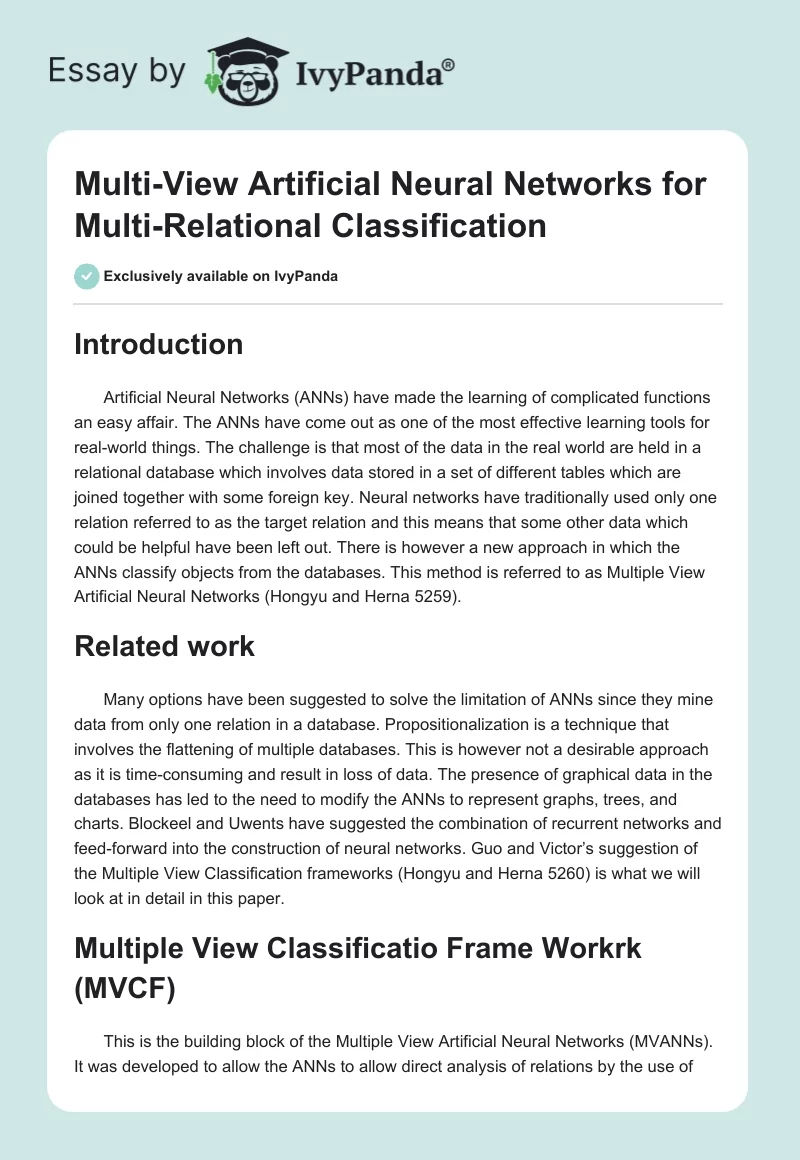Introduction
Artificial Neural Networks (ANNs) have made the learning of complicated functions an easy affair. The ANNs have come out as one of the most effective learning tools for real-world things. The challenge is that most of the data in the real world are held in a relational database which involves data stored in a set of different tables which are joined together with some foreign key. Neural networks have traditionally used only one relation referred to as the target relation and this means that some other data which could be helpful have been left out. There is however a new approach in which the ANNs classify objects from the databases. This method is referred to as Multiple View Artificial Neural Networks (Hongyu and Herna 5259).
Related work
Many options have been suggested to solve the limitation of ANNs since they mine data from only one relation in a database. Propositionalization is a technique that involves the flattening of multiple databases. This is however not a desirable approach as it is time-consuming and result in loss of data. The presence of graphical data in the databases has led to the need to modify the ANNs to represent graphs, trees, and charts. Blockeel and Uwents have suggested the combination of recurrent networks and feed-forward into the construction of neural networks. Guo and Victor’s suggestion of the Multiple View Classification frameworks (Hongyu and Herna 5260) is what we will look at in detail in this paper.
Multiple View Classificatio Frame Workrk (MVCF)
This is the building block of the Multiple View Artificial Neural Networks (MVANNs). It was developed to allow the ANNs to allow direct analysis of relations by the use of algorithms. The rationale behind this approach is that multiple users can retrieve data from different relations in the relational database. The MVANNs builds on the MVCF by adding two methods. Firstly, the algorithm will mine more relevant data from the target related to the other background relations. Secondly, the ANNs employ such mining techniques that will not only avoid overfitting but also enhance efficiency (Hongyu and Herna 5260).
The MVNN algorithm was tested on a variety of databases and the results juxtaposed with FOIL and CrossMine algorithms for comparison purposes. FOIL uses a hierarchical approach from the top to the bottom in establishing rules. CrossMine is an extension of the FOIL approach with the improvement of scalability and accuracy. It was realized that the MVNN approach yielded more desirable results as opposed to the other two algorithms. One of the strengths of MVNN is that it allowed for the automatic classification of objects from a set of relations without loosing efficiency. It also allowed for the mining of the data from multiple relations without making it imperative to export the data to another universal relation (Hongyu and Herna 5260).
Conclusion
The concept of mining data from background relations when using ANNs has been one of the biggest research problems. Guo and Victor have introduced an algorithm that makes the concept of mining of data from the background relations possible. The MVNN algorithm successfully allows for the ANNs to retrieve data from a number of relations without having to combine the resultant data into another new relation.
The MVNN algorithm was tested against some real learning problems and the results were compared to those of other algorithms like FOIL and CrossMine algorithms. It was observed that MVNN recorded accuracy levels incomparable to those of the other algorithms. It can therefore be concluded that MVNN can be used to classify as well as combine multiple relations in the most effective and efficient manner. It allows for the analysis of data stored in the background relations.
References
Hongyu, Guo & Herna, Viktor. Multi-view ANNs for multi-relational classification. International Joint Conference on Neural Networks, (2006) 1: 5259-5265.



